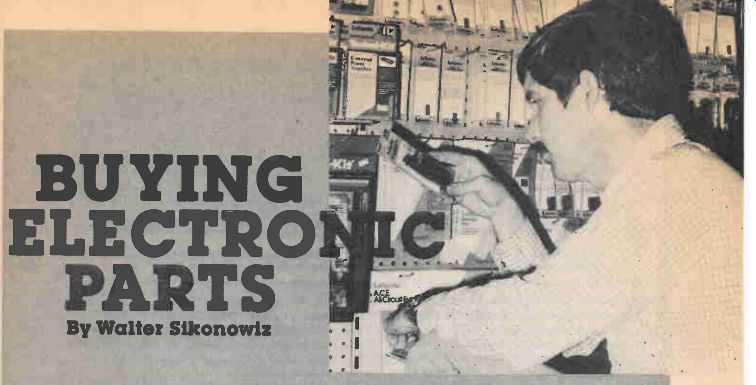
By Walter Sikonowiz
With some advance planning and the knowledge of where to start looking, the hobbyist can save a lot of time and a lot of aggravation, not to mention, some cold cash, by following these simple guidelines in pursuit of those hard to-find electronic parts that are essential to the completion of that challenging electronic project....just waiting to be built.
Ask a group of electronics enthusiasts what the single most difficult part of project building is, and more often than not the reply will be, "Buying the friggin’ parts." Such an attitude is not unwarranted because, try as you may, you will never find one distributor capable of supplying all the parts you need. Even so, there is no reason for the incredible amount of difficulty experienced by some people.
If you're planning to build a particular group of projects at once or in a series, then it may be of help to plan in advance, and only have to make one or two parts orders by mail, or the same number of trips to the local parts stores. Buying in larger groups can also cut costs, because some houses give discounts for purchases of the same part in excess of five pieces.
Your savings can really add up if you exercise some prudence in shopping.
The Big Four
You start by collecting catalogs; the more the better. Ten will get you by, but twenty is not too large a figure. Begin with the Big 4: Mouser Electronics (2401 Hwy. 287 N., Mansfield, TX, 76063), McGee Radio ( 1901 McGee St., Kansas City, MO, 64108), Dick Smith Electronics ( P.O. Box 8021, Redwood City, CA, 94063), and Radio Shack (just about everywhere). These are the general practitioners of electronics; they dispense a little of everything.
The Specialists
Once Ohm's Syndrome takes hold, however, and your sales resistance rises in the face of inflation (and limited selection), it's time to see a specialist. This might be any one of several firms selling certain products, such as integrated circuits, and little else.
Because of specialization, these companies can afford to have very complete inventories of selected merchandise. Furthermore, although you might expect a specialist to slap you with a fat fee, in most cases just the opposite will happen; you'll save money.
Who are these specialists? They are the mail-order businesses that advertise in the back pages of electronics magazines. Some of these companies restrict themselves to new merchandise, which they sell at very agreeable rates because of low overhead.
Others sell only surplus, that is, unused components obtained from manufacturers willing to sacrifice some inventory for ready cash. A component's appearance on the surplus market can be caused by a multitude of economic factors which are unfortunate for the manufacturer, but a windfall for you, the buyer.
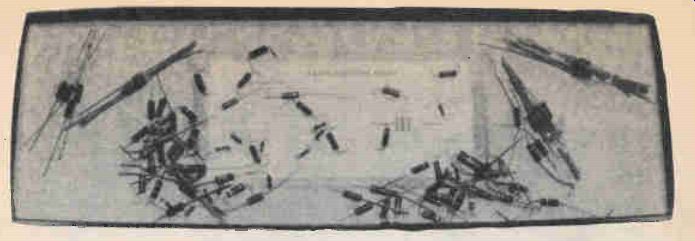
---------- Since a great many people have trouble remembering the
color code, a useful aid to sorting surplus resistors is an old tie
box with the color code marked inside the lid.
New or Surplus?
How can you tell whether merchandise is brand new or unused surplus? In many instances, the catalog will tell you. If not, there is one sure indication: If the merchandise is being sold for a fraction of the retail price you would expect to pay, it's surplus. Two firms that deal exclusively in surplus are Delta Electronics ( 7 Oakland St., Amesbury, Massachusetts, 01913) and John Meshna Inc. ( PO Box 62, E. Lynn, Massachusetts, 01904). Others, like Poly Paks ( PO Box 942, South Lynnfield, Mass., 01940), or Herbach & Rademan ( 401 E. Erie Ave., Philadelphia, Penn., 19134), offer a mixture of surplus and brand new stock. Regardless of whether the merchandise is new or surplus, all firms offer some guarantee of satisfaction.
In order to get better acquainted with the various suppliers, let's survey the market item-by-item. In the following paragraphs, whenever a specific company is mentioned in connection with a component, it is only because that firm is particularly strong in a certain area. Some degree of overlapping does exist among all firms, however, so don't assume that any one supplier is being recommended to the exclusion of all others.
Integrated Circuits
Although human life is based on the chemistry of carbon, it is the chemistry of silicon that now forms the basis for our business and industry, thanks to the integrated circuit. Because of their tremendous importance, integrated circuits are sold by almost every electronics supplier, big or small. You'll find that the Big 4 have quite respectable IC inventories, but their selections are certainly not complete. Jameco Electronics, 1355 Shoreway Road, Belmont, CA 94002 and Ancroma Corp. (PO Box 2208, Culver City, Calif.,90230) feature perhaps the widest selections of ICs; linear, TTL, CMOS, DTL, ECL, LSI and so forth.
Digi-Key ( PO Box 677, Thief River Falls, Minn., 56701) also features a wide assortment, including some circuits difficult to find elsewhere. Last, but not least, there is Solid State Sales ( PO Box 74A, Somerville, Mass., 02143). Although this company's selection may be a trifle smaller than some, its service is like the fabled "greased lightning." Occasionally you are going to receive a dud. When this happens, it's best not to go berserk. A calm request for a replacement is usually accommodated very quickly. After all, these companies want your continued business in the future. As a precautionary measure, you might consider ordering two of each IC. The chances of getting one dud are so small that the probability of receiving two duds simultaneously is infinitesimal. You can use the extra IC, if it is good, in a future project.
Occasionally, the inevitable happens, and you will find yourself with an inoperative circuit. If you have any reason to suspect the IC as the culprit, either from poor handling technique, or from having eliminated any other possible causes, a spare IC will cure many late-night headaches caused by projects that have no good reason not to work. Try the new IC before you burn the schematic!
Discrete Semiconductors
This category is an exceptionally broad one. Included are: bipolar transistor, FETs, SCRs, diodes, UJTs and so on. As in the case of ICs, almost everyone sells some discrete semiconductors, but few vendors stock each part number. Before giving up an elusive part, try either Hanifin Electronics Corp. ( P.O. Box 188, Bridgeport, PA 19405), or the Ancrona Corp. These two firms have perhaps the most extensive listings of discretes.
Most suppliers offer special discounts to encourage volume buying of parts. This appeals directly to the squirrelish instincts of the electronics hobbyist, but be careful. Just like that greedy little tree-dweller, you will probably horde more than you can ever use. If you must stockpile parts, do it sensibly. Choose those discrete components that are most frequently used: 2N3906 PNPs, 2N3904 NPNs, 1N914 switching diodes, 1N4003 rectifiers and so forth. Avoid the high wattage zener diodes now appearing in surplus.
Today integrated circuits have supplanted zeners as regulators at all but the lowest power levels.
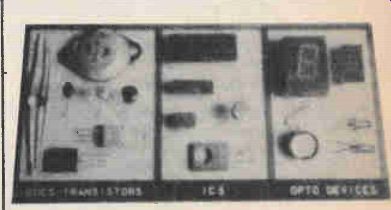
----- Try to build up the supply of transistor, diodes, ICs, and electro-optical devices.
Resistors
Buying from one of the larger retailers, you can expect to pay around 10 cents a piece for carbon composition resistors. Compare that with the typical 4-cent selling price from the specialist firms, and the choice of a supplier is obvious. Resistors are one class of component that can be sensibly stockpiled.
Buy half-watters with a 5°h tolerance. They cost only a bit more than 10% resistors and save you the trouble of stocking two tolerances.
Most construction projects are designed to utilize resistors with a tolerance of 10%, unless specified otherwise in the parts list.
Power resistors, with ratings from 5 to 100 watts, are available from the surplus dealers at incredible prices.
Buy a small assortment. Power supplies and audio amps often need dummy loads during checkout, and for such purposes these high-power resistors are ideal. If you do not have exactly the right resistance at hand, use serial and parallel combinations whose net resistance is the desired value.
Don't forget those high-class resistors, the metal film precision units with tolerances of 1% or better.
You can get these from the larger retailers, but at 60 cents to one dollar a piece (often with a ten-piece minimum order) who needs them? Actually, for certain ultra-stable or low-noise circuits, precision resistors are mandatory. Active filters, accurate voltage dividers, and analog-computer circuits are but a few examples. When you really need precision resistors, Hanifin Electronics can supply them at about 15 cents each. But because Hanifin is an industrial supplier, do not send in a 75e order; fifteen dollars worth is a realistic minimum. Since Hanifin offers lots of goodies besides resistors, you should have no trouble putting together a good-sized order.
Capacitors
The best all-around capacitor that money can buy is the polystyrene type. It also happens to be one of the cheapest, a fortunate coincidence. Polystyrenes are available in the range from 5 pF to 0.5-uF, but above .01-uF, they begin to get bulky and expensive.
Your best and most complete sources for these capacitors are Mouser Electronics and Digi-Key.
Standard tolerances are 5% (super for a capacitor), with 2.5% and 1% available at higher prices.
In the range from 0.01-uF to 1-uF, you are best off with mylar (polyester) capacitors. (Mylars are available outside this range, too.) Standard tolerances are 20% and 10%. A great many firms carry mylar capacitors.
Above 1-uF, most capacitors are aluminum electrolytics, which are polarized devices. One of their most important functions is filtering, particularly in AC power supplies. Tolerances tend to be relatively loose since applications rarely call for very precise electrolytic capacitors. Capacitances as high as 40,000-uF and beyond are available.
The aluminum electrolytic has a more sophisticated cousin, the tantalum capacitor, which is commonly available in capacitances as high as several hundred microfarads. Relative to the aluminum electrolytic, the tantalum features tighter tolerances (10% typically), lower leakage, and smaller size for equivalent capacitance. As a result, tantalums are preferred over aluminum electrolytic in timing applications. Both electrolytic types are stocked by many distributors.
Surplus capacitors are available, with perhaps the best source being Poly Paks (see above), at least in terms of variety. If you do buy surplus capacitors, play it safe and check each one on a capacitance meter.
Ceramic bypass capacitors for digital logic are available very cheaply as surplus, and so too are mylars. On the other hand, be very cautious when buying surplus aluminum electrolytic capacitors.
They have a limited shelf life, and once they dry out, they are useless. Most dealers are scrupulous enough not to do this to you, but you can end up with a relic of the 1950's that looks more like an artillery shell than a capacitor. Choose carefully.
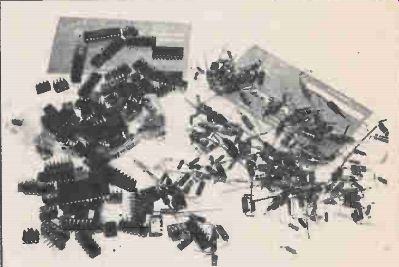
---------- You can buy bulk components at next-to-nothing prices if
you buy untested, surplus parts. Poly Paks is a popular bulk supplier
and two of their packs are shown here. Most of the parts are useable.
Potentiometers
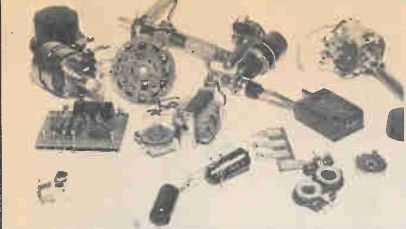
----------- The best way to build up your parts inventory is to salvage useable components from Junked pieces of electronics gear. Transformers, switches, potentiometers, crystals and coils are always handy to have.
New pots cost about the same no matter where you buy them. Imported units may sell for less, but cheap materials yield an inferior device, one that is often difficult to turn because of high-friction bearings.
While imports are excellent for experimenting, it always pays in the long run to use top-quality pots in your projects.
Surplus pots can save you a lot of money, but read the fine print closely. Pay attention to shaft length.
Some units are intended for screwdriver adjustment and have short, slotted shafts which cannot accept a knob. In addition, watch out for strange tapers, such as "reverse logarithmic." Pots specified as having either "linear" or "audio" tapers are the ones most usually called for in projects.
You will find that only linear and audio taper potentiometers are called for in the circuits described in this magazine.
For some reason, wirewound pots seem to abound in surplus. These are fine for low-frequency work, often at high power. But wire-wounds have poor resolution and should never be used in a circuit where very precise adjustments must be made. For the bulk of your experimenting, standard carbon composition pots are your best choice.
Slide pots are a great convenience in audio work, especially if you are building a mixer or music synthesizer. Many outlets carry them, but most units have too short a path of travel (11 A inches) to be really useful. Slide pots with twice the adjustment range are preferable, and they can be purchased at reasonable cost from Mouser Electronics.
Relays
These may well share the fate of the dodo, thanks to fast and reliable solid-state switchers like triacs, SCRs and transistors. Industrial control systems that once bristled with relays and cam-actuated microswitches now rely on digital logic and thyristors. Even Ma Bell, at one time the patron saint of relay manufactures, now uses electronic switching to route calls. The result of all this phasing-out is a surplus market chock full of relays at bargain prices.
Despite the decline in its commercial popularity, the relay still possesses some admirable qualities, such as excellent driver/load isolation and minimal temperature sensitivity. Furthermore, it happens to be one of the easiest devices for the beginner to understand and use. All things considered, it makes sense to take advantage of the surplus bargains now, while they last.
Power Transformers
Here is another item carried by almost every supplier, but inventories are generally limited in scope. When your application demands just the right transformer, it pays to be able to order directly from the manufacturer. Signal Transformer Co. ( 500 Bayview Ave., Inwood, N.Y., 11696) offers a wide array of transformers, from tiny, PC-mount devices to mammoth, kilowatt isolation transformers. Other makers also offer diverse selections, but some may not encourage direct mail ordering.
Undoubtedly the most economical way of securing a transformer is through a surplus dealer like Delta.
Many kinds of transformers end up as surplus, and with just a little luck you can find one to suit your purposes. Discounts greater than 75% off list are common, so the money you save may be substantial.
This is especially true if you are planning to construct something big such as a high-powered audio amplifier. Transformers from some of the best amps ever to shake a loudspeaker end up as surplus, victims of design changes and competition.
Printed Circuit Stuff.
There is no surplus material worth mentioning in this category, so let's focus on new merchandise. The simplest PC methods involve placement of a pattern directly on copper-clad board. These are fine in the beginning, but for serious experimenters, photo graphic techniques are a must. Not only do photographic methods yield neater copper traces and a greater density of components on your board, they also allow any number of boards to be produced from a single piece of artwork.
Photographic PC processing can best be learned from one of the kits offered by various manufacturers.
You do not need expensive equipment like a camera or enlarger. All necessary materials and instructions come in the kit. These PC kits may employ either negative or positive photographic processes, which differ from one another principally in the method used to prepare a board's artwork. Positive methods are perhaps easier for a beginner to visualize, but negative kits seem to be equally popular. Most suppliers carry at least one brand of PC kit, if not more. Choose one that fits your needs and budget.
You'll find the professional-looking results to be well worth the extra effort.
Although only the tip of the iceberg has been exposed here, you should have a pretty good idea of how to find supplies by now. To obtain copies of the catalogs you want, write directly to the companies mentioned in the text. Note that our coverage has been by no means exhaustive. Undoubtedly other worthwhile catalogs are available, so hunt carefully through the back pages, too. Remember, all companies stock much more merchandise than they can economically include in a single magazine advertisement.
Now that you have a pretty fair idea of how to purchase the parts you'll need for the projects you plan to build, sit down and compile a master parts list.
As you do this, you'll probably start to see the same parts cropping up time and time again. To avoid unnecessary duplication only buy a part twice (or more) if the project it is being used for is one of a permanent nature. If you're going to tear it down, you can use its parts for another project at a later time.
Also see: Getting Started With Electronic Projects
More from EH magazine: Tandy's Radio Shack
Adapted from: Electronics Handbook--Spring 1987